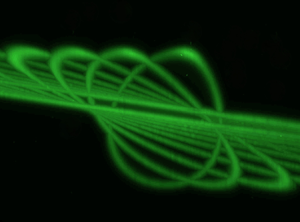Published online by Cambridge University Press: 11 January 2022

The interplay between chemical reaction and substrate deformation is discussed by adapting Ranz's formulation for scalar mixing to the case of a reactive mixture between segregated reactants, initially separated by an interface whose thickness may not be vanishingly small. Experiments in a simple shear flow demonstrate the existence of three regimes depending on the Damköhler number  $Da=t_s/t_c$ where
$Da=t_s/t_c$ where  $t_s$ is the mixing time of the interface width and
$t_s$ is the mixing time of the interface width and  $t_c$ is the chemical time. Instead of treating explicitly the chemical cross-term, we rationalize these different regimes by globalizing it as a production term involving a flux which depends on the rate at which the reaction zone is fed by the reactants, a formulation valid for
$t_c$ is the chemical time. Instead of treating explicitly the chemical cross-term, we rationalize these different regimes by globalizing it as a production term involving a flux which depends on the rate at which the reaction zone is fed by the reactants, a formulation valid for  $Da>1$. For
$Da>1$. For  $Da<1$, the reactants interpenetrate before they react, giving rise to a ‘diffusio-chemical’ regime where chemical production occurs within a substrate whose width is controlled by molecular diffusion.
$Da<1$, the reactants interpenetrate before they react, giving rise to a ‘diffusio-chemical’ regime where chemical production occurs within a substrate whose width is controlled by molecular diffusion.